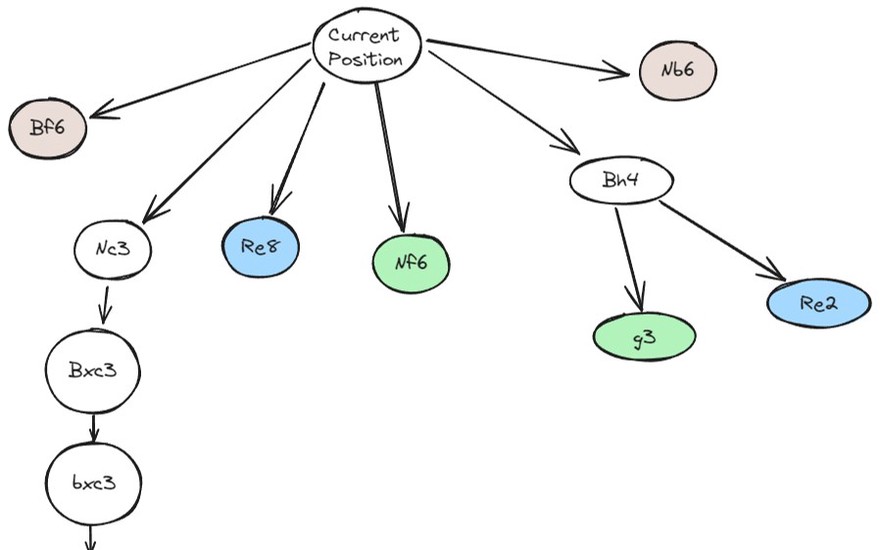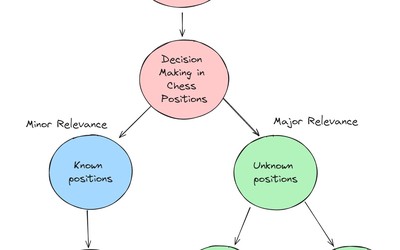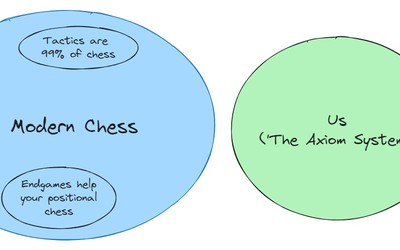
The Axiom System - Part 1 - Introduction
I'm writing this because I have come to believe that much of modern chess culture is involved in a deep self-deception.This article is also available on my personal website.
Quick Note
Unlike most posts on lichess that are self-contained and end with definitive conclusions, this post is the first in a series of about ten articles. Please do not expect definitive conclusions by the end. Given the total length of this endeavour, some may find this post overly verbose compared to a typical post. For those readers, I will be releasing a much more concise summary outlining the main points made throughout the series, which you may prefer. I am doing this to try and meet the preferences of everyone. Thank you.
An adult newcomer to chess might find themselves simultaneously impressed yet overwhelmed by the game's extensive literature, rich knowledge base, and specialized terminology. A game that may seem relatively simple at first, but reveals layers of complexity to those who delve deeper. Overall, one gets the impression that they are entering into a realm where expertise has been layered and cultivated over time.
Like many who have taken up chess in their youth, I've been deeply immersed in its culture for most of my life. However, in recent years, I've found myself becoming increasingly disenchanted with it.
I'm writing this because I have come to believe that much of modern chess culture is involved in a deep self-deception. It generally presents its core beliefs with unwavering confidence and a stoic facade. However, upon closer examination of its responses to the most critical questions, one discovers a surprising shallowness. My critique is not related to our proficiency at the game, rather in relation to how we conceptualize the different aspects of the game, especially in relation to its practical side.
I find that many of the accepted ways of describing chess and how it is played paint a picture that is largely divorced from reality. There are several consequences of this distorted view, one significant outcome being that numerous widely endorsed approaches to chess improvement lack a solid foundation. In this series of articles I aim to justify these statements.
Introduction to the Axiom System
That being said, I've never been a fan of armchair critics. For example, the movie critic that has never been on set, or the music critic that has never composed a melody. Therefore, I have been crafting my own framework for understanding practical chess, which I’m calling ‘The Axiom System’. I've named it such because the concept of an axiom plays a significant role within the system, but also simply because I like the look and sound of the word 'Axiom'. If you clicked on this article you may have thought that I was referring to a new opening system or something similar. However, this article, as well as others in the series, will not be focusing on the latest opening trend or anything similar. Rather, we will be focusing on more ‘meta-chess’ ideas.
I’ve been working on these ideas for some time now, but have recently thought that I may as well write some articles to share them, bit by bit. This article will serve as the introduction.
I’m aware that this may all seem a bit abstract so far. However, as we delve deeper in subsequent articles, I'll provide clear, actionable insights designed to enhance your chess skills. In an attempt to give at least some idea of what I’m talking about, I’ve been thinking of a way to summarize the essence of the critique in a simple way, and I have come up with the following. Remember, the following is simply a 'large world' view of the critique, and we will be much more rigorous and precise in subsequent articles.
Descriptive vs. Practical Chess
Much of chess culture takes a descriptive perspective - it attempts to describe the various aspects of chess positions. We define terms to describe positions, such as doubled pawns, bad bishops, outposts, color complexes and so on. This is similar to when, for instance, an entomologist attempts to identify, categorize and ultimately describe different types of insects. It is very much an academic process.
This approach not only describes the game but also theorizes relationships between these terms. For example, the Sämisch Variation of the King’s Indian Defence is not so critical because it so heavily weakens white's central dark-square complex. In other words, it seeks to establish a logic of chess, so to speak.
In the starting position of above puzzle, notice that white's light squares around their king are extremely weak. The main piece doing the heavy lifting in controlling these light squares is the knight on d2. Therefore, it seems logical that the answer to the puzzle involves sacrificing our rook for this knight before conducting our light-squared attack. This is a good illustration of 'the logic of chess'.
This general approach to chess focuses on the chess position itself, rather than the player looking at the position. This distinction may seem subtle now but its significance will become clearer in subsequent discussions.
This is all well and fine, and is even interesting in its own right. However, while much emphasis is placed on this descriptive perspective of chess, little is said about chess from a practical point of view. This is especially strange given that most people are concerned with the practical nature of chess - that is, becoming a better chess player - than they are about constructing a 3rd person, logic of chess (hardly anyone is specifically interested in this).
You may think, 'Of course people talk about the practical side of chess!' Discussions about aspects like confidence, psychology, and time management are indeed common. However, these topics still skim the surface of a more fundamental issue: addressing the question "How do we actually make decisions when we play chess?"
Through exploration of this question, we will be able to arrive at more fruitful answers to the question of chess improvement that many seek.
In summarizing my critique, the essence is that chess culture has implicitly favored a descriptive lens as the optimal way to discuss practical chess improvement. We often assume that the defined, descriptive concepts are the best tools for enhancing one's play. However, I believe this assumption is misguided.
Analogy to Football: Descriptive vs. Practical Insights
To illustrate this distinction between the descriptive and the practical, let's consider soccer/football. If you are a fan of the sport, you may have seen a pundit analyze a certain passage of play. For example, consider Thierry Henry's recent detailed analysis of a Kylian Mbappé goal, where he dissected the effectiveness of Mbappé’s coordination and shooting technique.
While we could develop a set of concepts and terminology to describe these observations - a sort of "logic of football" - such analysis, though interesting, is not especially useful for someone aspiring to improve their football skills. It is crucial to note that Mbappé didn't rely on a theoretical framework or make conscious calculations during the play; his actions were instinctive, honed through practical experience rather than descriptive analysis. I think this fact is rather uncontroversial.
Therefore, we have differentiated between the descriptive (Henry’s fine grained analysis) and the practical (Mbappé’s instinct in the moment), and moreover we appreciate that they are relatively independent.
The Disconnection in Chess
Contrastingly, in chess, discussions about practical improvement heavily rely on tools borrowed from the descriptive realm. Sometimes these tools are useful, but more often they are not.
The goal of the Axiom System is simple: Lay the groundwork for a more comprehensive practical perspective of chess. Instead of describing chess itself, we aim to describe how we play chess. Instead of analyzing and documenting why Mbappé’s movements are effective, we aim to analyze how we can become closer to performing like Mbappé ourselves.
I can already sense the objections forming in the reader’s mind - "Of course descriptive concepts like doubled pawns and weak squares are necessary for understanding and improving at chess!".
However, I urge you to hold any judgments for now, as I am yet to make any arguments at all. I am simply asserting certain statements for the purpose of previewing the general types of conclusions we will arrive at when I present my arguments in subsequent writings.
Just as an entomologist who has landed on Earth for the first time and is tasked with forming a descriptive view of insects from scratch, we will similarly start from the beginning to develop our practical view of chess (the reason for which I will explain in the next article).
A Short Note On The Challenge of Communication: The 3 Cs
Through my experiences in content creation and presenting arguments across various topics, I've formulated what I call the rule of the 3 Cs: when presenting an argument, you can only optimize two of these three elements: clarity, conciseness, and comprehensiveness.
- Clarity and Conciseness: Achieving both often means omitting critical details, nuances and qualifications of an argument. You lack comprehensiveness.
- Conciseness and Comprehensiveness: This combination requires dense language that can be overwhelming and hard to follow, leading to loss of audience engagement. A good example of this is with the field of Philosophy - some philosophers can pack a lot of information into a short paragraph, but it is often very difficult to understand what is being said. You lack clarity.
- Clarity and Comprehensiveness: Opting for this means occasionally repeating information in different ways and providing numerous examples for demonstration purposes. You lack conciseness.
My preference is for clarity and comprehensiveness. I realize this choice may cost me some of my audience's attention - which has definitely already happened for some people reading this article - as evidenced by feedback on my YouTube tactics video, where a viewer commented, 'You need to get to the point faster if you want to engage your audience’ (thanks for that pointer, by the way).
So apologies in advance if you do not have the time (or patience....) to follow along when you otherwise would’ve liked to. To accommodate different preferences, I will also publish standalone articles that do not require background knowledge on topics like justification in chess, reviewing your own games, evaluation in chess, among others.
Looking Ahead
In the next article in this series, I will describe what a typical argument in chess looks like and use this to explain why it is crucial to build our practical perspective from the ground up. I’ll also be attempting to partially justify my statement that much of the time, chess culture’s answers to critical questions are often surprisingly shallow, so please follow this account to get notified when I post part 2.
Even if my views do not entirely resonate with you, I hope to at least offer a perspective that is interesting.
Part 2 is now available here.
P. S. Daily Chess Challenge
Improvement in Chess requires consistent, active training. That’s why I created Daily Chess Challenge, where you receive high quality chess training material in your inbox every day to help you improve. It’s completely free and all you need to do is input your email address. You can sign up in 2 seconds here.
More blog posts by DailyInsanity

Cheating: Trust and Traitors in Chess
How can we simultaneously tackle the two heads of the cheating beast — detection and trust?
The Axiom System - Part 3: How Do We Make Decisions
In the previous article, I explored the idea of starting from scratch to develop a framework for und…
